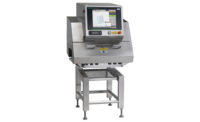With food safety top of mind for dairy processors and consumers, equipment that can locate foreign objects in products is critical. Yet successful detection can be tricky.
Such elements as product effect and insufficient calibration can result in inferior performance, including false positives. That reality is leading technology providers to develop systems that can better pinpoint foreign materials during production.
“Many companies in the food metal detector market are using different technologies in their product to develop advanced product,” reports Portland, Ore.-based Allied Market Research. “Technological advancement in the metal detection machines for the food industry are offering qualitative as well as quantitative analysis of the manufactured food item.”
Device improvements, for instance, are enabling processors to uncover smaller objects while supporting a wider range of dairy products, says Todd Grube, product manager, inspection systems for Heat and Control Inc., a Hayward, Calif.-based manufacturer of metal and X-ray detectors.
Such technologies include the use of multiple frequencies that run simultaneously and are enhancing detection probability, says Yuanjun Chloe Lu, application specialist, product inspection for Thermo Fisher Scientific Inc., a Waltham, Mass.-based provider of metal and X-ray systems.
“If a contaminant signal is too low to be detected on one frequency, another frequency setting may detect it,” she states.
The system is an upgrade from when metal detectors had two or more frequencies on the detector head, but only one was used at a time, says Ryan Spencer, product market manager – chambers, portioning, and slicing for Multivac Inc., a Kansas City, Mo-based provider of metal and X-ray technologies. He notes that the newer designs “allow the system to analyze the electromagnetic signal and cancel out the disturbances made by the product itself, which makes finding smaller metal contaminants possible.”
In addition, newer user-friendly devices are enabling operators to more conveniently set up and maintain metal detectors. They also allow a single quality control inspector to easily monitor the performance of multiple detectors from an office environment, says Barry Voorhees, metal detection product manager for Bunting, a Newton, Kan.-based equipment developer. “This frees up time for the inspector to perform other quality control tasks while ensuring the absence of metal contaminants in the product,” he states.
Software joins the evolution
Improvements to metal detection software, meanwhile, are simplifying documentation of the equipment’s usage, says David C. Smith, sales manager for Advanced Detection Systems, a Milwaukee-based metal detector developer. That includes enabling logged events to easily transfer to permanent records while indicating the metal detector settings, detection events, and the product being run with a time and date stamp.
Security upgrades include additional password capacity to better prevent unauthorized personnel from changing detector settings, he notes.
“These enhancements reduce time spent on recordkeeping and reduce errors in metal detector data collected manually,” Smith states.
X-ray inspection systems, meanwhile, are using new image analyzing algorithms that inspect the conformity of products and packages. They are also using artificial intelligence algorithms and deep learning to enhance detection of foreign bodies and quality defects, says Max Uusitalo, business development manager at Mekitec Ltd., an Oulu, Finland-based detector manufacturer.
X-ray technologies can also act as a “quality check” on metal detectors when there are false positives while detecting smaller pieces of stainless steel and compatible gasket pieces, says Norman LaVigne, founder of Valcour Process Technologies, a Peru, N.Y.-based distributor of X-ray and metal detectors for the cheese and dairy industries.
The most accurate inspection rates occur when operators analyze final products in their primary packaging, Uusitalo says. The consistency among the products “makes it easier to spot anomalies or hazardous foreign bodies,” he notes.
Having multiple lines of metal detectors in dairy plants can further improve results by enabling operators to check for metals in various parts of the processing system, states Brian Poulsen, managing director of Detectronic A/S, an Aalborg, Denmark-based metal detector manufacturer. “It not only makes the product more secure from a metal contamination point of view but also allows the processer to pinpoint where the metal originates,” he states.
Keep track of the technologies
To best gauge and maintain inspection equipment performance, operators should regularly evaluate systems in isolation or randomly during production, Grube says.
“The test samples should be detected 100% of the time,” he notes. “In the event of a failed test, product since the last successful test typically will need to be put on hold until the reason for the failure can be determined and rectified.”
Smith states that the testing process “will uncover the conductive signal of the product and provide information related to product orientation and the effect of product temperature on ferrous, nonferrous, and stainless-steel detection levels. Such details may guide a dairy processor to adjust a product line to achieve better metal detector performance.”
Monitoring false rejects, which contribute to product waste and lost production time, can enable processors to determine the effectiveness of inspection equipment as well, Grube notes.
“Many challenges associated with detecting foreign objects in dairy products can be associated with easily resolvable issues such as incorrect configuration,” Voorhees says, adding that automated testing systems are able to further improve security by adding test cycles that do not rely on human interaction and are not prone to operator error.
For best results, processors should calibrate their detectors to the specific food they are processing and then set a threshold governing the size of contaminant they want the detector to reject, says a spokesperson for Detectapro, a Menomonee Falls, Wis.-based provider of metal detectable products.
The spokesperson adds that it is critical for processors to continually check calibration as products can emit different signals due to changing moisture content — for example, in melting ice cream.
Indeed, accurate metal detection can be difficult, as many dairy products can present strong product effect due to moisture, salt, and/or fat content, Grube says. Product effect refers to a product that has conductive or magnetic properties that affect the fields generated in a metal detector and can result in false readings.
“If the metal detector cannot distinguish between the product effect and metal contamination and this problem repeats itself, it can have a massive impact online performance,” says Eric Garr, regional sales manager for Fortress Technology Inc., a Toronto-based metal detector manufacturer.
Address the product effect problem
Multi-frequency systems that use two or more frequencies concurrently are “state of the art” in metal detection and are helping to reduce product effect for better detection results, Spencer says.
“Product effect is the way that good, uncontaminated product disrupts the electromagnetic field generated by the metal detector coils,” he states. “Products with a lot of moisture and salt content disrupt the field to a greater degree because water and salt are electrically conductive. This makes it more difficult for the metal detector to ‘see,’ via disturbance of the electrical signals, metal contaminants.”
In addition, the foil seals on yogurt containers can eliminate the ability to use a metal detector on the final packaged product, Grube states.
“The product effect and foil packaging issues with metal detectors can be avoided with X-ray machines,” he notes. “However, even X-ray performance will be reduced on thick, dense product such as large blocks of cheese.”
Indeed, while product effect is not an issue in X-ray detection, inspecting packaging “can be a challenge in things like glass jars,” says Robert Rogers, senior food safety advisor for Mettler Toledo LLC, a Columbus, Ohio-based developer of metal and X-ray detectors. He notes that it can be difficult for the X-ray to “see” blind spots in sidewalls and that glass contaminants in a glass package can be harder to detect.
X-ray systems, however, are incorporating high-resolution detectors and multiple energy sources such as two or three generators versus the one generator typically found on standard and entry-level X-ray machines, Lu says. She notes that the measures are enabling users to detect less-dense contaminants such as bones, eggshells, and plastic, along with a wide range of metallic and non-metallic foreign objects, including glass and stones.
“X-ray inspection has emerged as a better inspection option, not only for finding foreign materials but for detecting quality defects such as missing or broken components,” Lu states. “The systems have become easier to use, more reliable, and more affordable.”
Even with X-ray and metal detectors becoming increasingly effective, identifying all foreign objects in dairy products remains challenging because of the differences in product forms, formulations, and densities, Grube says.
“Many dairy processors are using multiple technologies to increase the chance of detecting all contaminants,” he states.
It also can be difficult for processors to implement the optimal detection technologies because of system costs and the need to have the necessary floor space to house the equipment, LaVigne says. Indeed, the inability to detect ferrous and nonferrous material in food items from a single machine can require the installation of multiple detectors, states Allied Market Research.
Do your due diligence
When considering inspection systems, it is critical that processors learn the capabilities and limitations of each option, Rogers says. “There is no ‘silver bullet,’" he states. “Oftentimes, the production needs influence the inspection capabilities.”
Rogers adds that product inconstancies in temperature, amount, presentation, moisture, and packaging — along with throughput — all require consideration when setting up an inspection system.
In addition, processors should request that potential suppliers provide data on a machine’s failure rates and replacement part costs, Garr says.
“If suppliers are not prepared to divulge these, that’s a red flag,” he states. “Factors like this have a huge impact on total cost of ownership.”
Operators, meanwhile, should consider both their current and future needs when making detection system choices, Lu says, noting that metal and X-ray equipment have fixed apertures and tunnel sizes, making it “difficult to impossible” to modify present equipment to accommodate new product dimensions.
Voorhees adds that processors should focus on three questions when attempting to determine the right technologies for their operations: 1) What are the results I need to achieve? 2) Who can provide these results consistently? 3) What is the most cost-effective solution?
It is also important that dairy plant metal detectors have high protection ratings against water intrusion due to the harsh sanitation conditions in a typical production environment, Voorhees says. And operators should review triple-frequency systems with multi-product learning capabilities that enable devices to achieve more reliable detection across various products.
“This allows producers to quickly react to new and trending items such as high-protein products without requiring service assistance from the metal detector manufacturer,” he notes.







